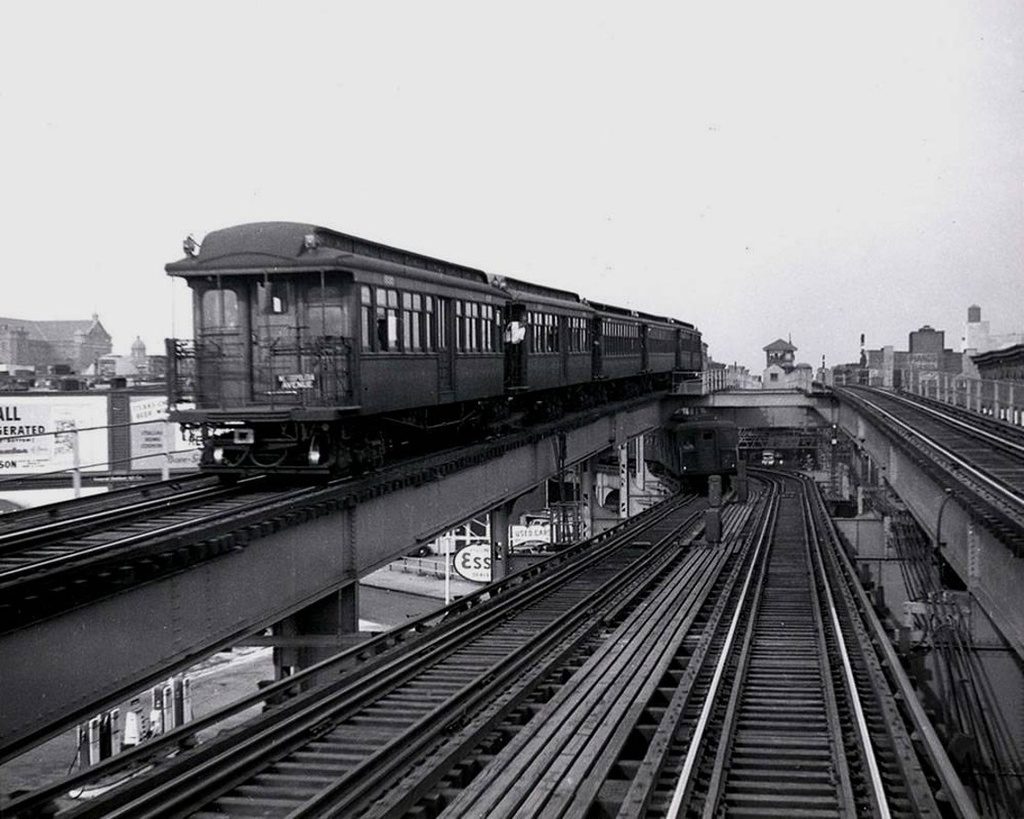
Starting in the summer of 2017 the MTA will shut down service along the Myrtle Ave Line (M train) from Broadway to Metropolitan Ave. The closure is so the MTA can rebuild a crumbling bridge and viaduct to allow for better service once the Canarsie Tubes of the L train are shut down for Hurricane Sandy related repairs. While this relatively small project is important for keeping the system moving it is really only a band aid on a larger issue: the BMT Jamaica and Myrtle Ave Lines have some of the oldest continually operating track structure in the entire NYC Subway and the junction at Myrtle Ave is a bottleneck along two lines which are seeing continued ridership growth due to the popularity of both Bushwick and now Bedford-Stuyvesant. This is a missed opportunity by the MTA to not just rebuild aging infrastructure but do so which eliminates a crucial bottleneck and expands capacity along both lines.
Both the Jamaica Line (J/Z trains) and the Myrtle Ave Line originally date back to the late 1880s when Brooklyn was still its own independent city and was growing rapidly. What we have with the M train today is only a vestige of a longer line which continued down Myrtle Ave to downtown Brooklyn and over the Brooklyn Bridge into Manhattan. The Myrtle Ave Line eventually had direct connections to many of the other Brooklyn elevated lines which have now been torn down as well. In 1914 the direct connection between the Myrtle Ave Line and the Jamaica Line at Myrtle-Broadway was opened allowing dual services to run, one via the Brooklyn Bridge and one via the Williamsburg Bridge. Originally a connection was planned from Chambers St station with the Brooklyn Bridge which would have allowed elevated lines to loop back into Brooklyn offering a variety of services. Such a system never came to pass as the new subways proved more popular than the old elevated lines which the city soon began to replace. After WWII the population of central Brooklyn declined and so too did ridership on the Myrtle Ave Line which ended downtown service in 1969. The elevated structure from downtown Brooklyn to Marcus Garvey Blvd was town down and all service east of Broadway ran exclusively to Manhattan via the Williamsburg Bridge.
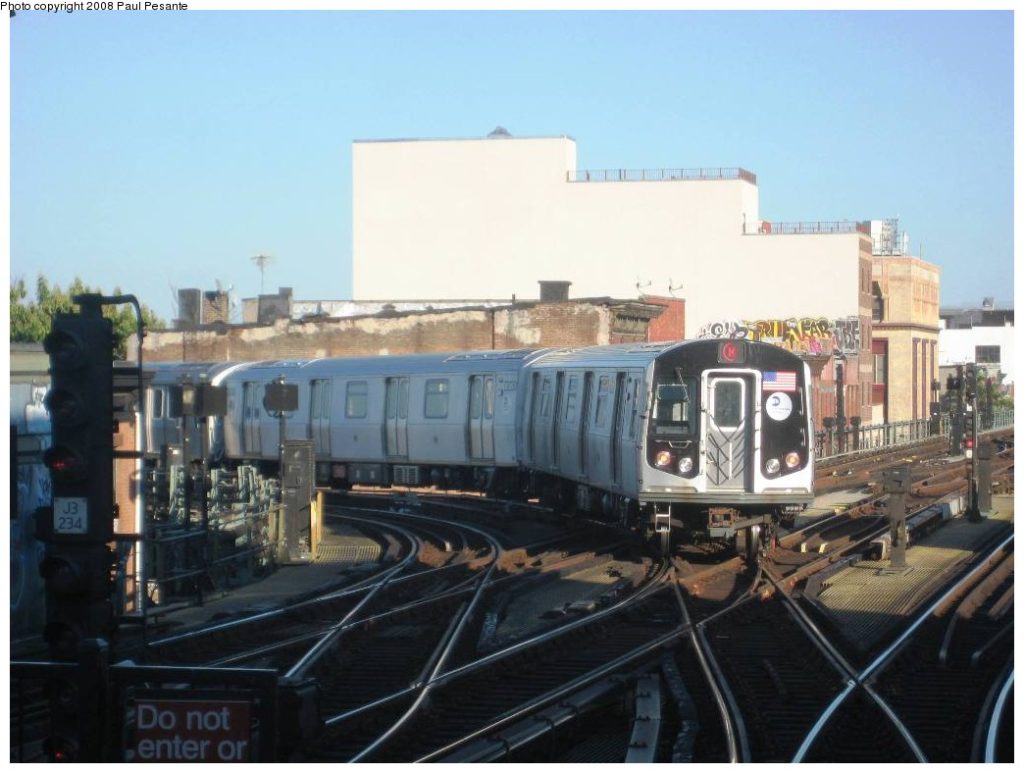
As the popularity of Williamsburg and Bushwick has grown over the last 20 years so too has ridership. In 2010 the M train was rerouted from downtown to 6th Ave which has proven very popular and an alternative to the crowded L train. This is where the bottleneck at Myrtle-Broadway starts to become an issue. As more trains are needed to account for ridership growth the at-grade junction keeps capacity limited. This wasn’t as much of an issue when the M train terminated at Broad St since the J/Z provided additional downtown service. But the M now continues on to Forest Hills via the notoriously congested Queens Blvd Line. Due to the bottleneck M trains can only be scheduled at about 8 trains per hour leaving time for up to 5 more trains per hour available if the bottleneck was removed (theoretically there could be as much as 15tph but due to congestion along 6th Ave and Queens Blvd realistically the max is 12 or 13 tph). Not only would this mean better service for Williamsburg and Bushwick but also for Queens as well.
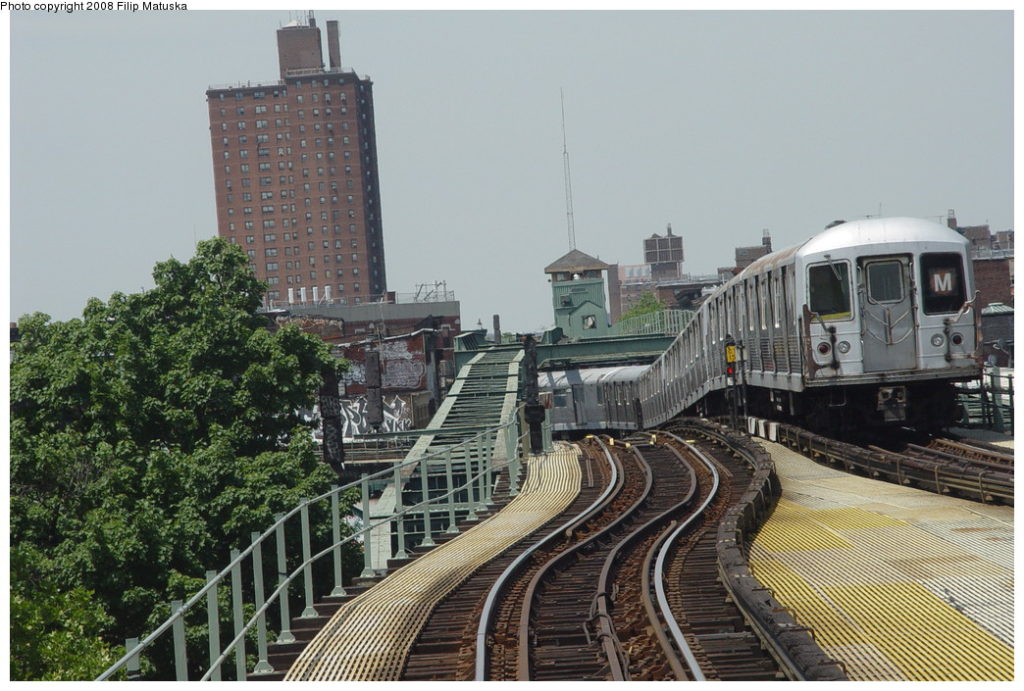
The MTA is planning on rebuilding the concrete viaduct that connects the Broadway Line with the Myrtle Ave Line but not eliminating the bottleneck. This bottle neck can be eliminated by building a new flying junction between the Flushing Av station and Myrtle Ave station. The current local tracks would be moved outward so that two new tracks can be added between. These two new tracks would connect to both the local and express tracks. As they approach Myrtle Ave the new tracks would rise up and a new upper level station would be built over the existing Myrtle Ave station, though slightly to the west. This new station would mirror the existing station with three tracks and two island platforms. The remnants of the old Myrtle Ave El would be removed south of Broadway so that the new tracks could be extended along the abandoned trackways as they turn down Myrtle Ave. The trackways are still in good shape as they are connected to the existing junction structure. This new upper level station would serve Myrtle Ave trains exclusively and the reason for the mirrored design is so elevators could be installed to connect the platforms. Additionally a third track could be installed between the new Myrtle upper level and the existing Myrtle Ave Line. A third track was installed between Central Ave and Wyckoff Ave but was only used for storage and was removed in 1946. With an increase in trains per hour a third track may be useful for turning trains at Wyckoff Ave at rush hour or for emergencies.
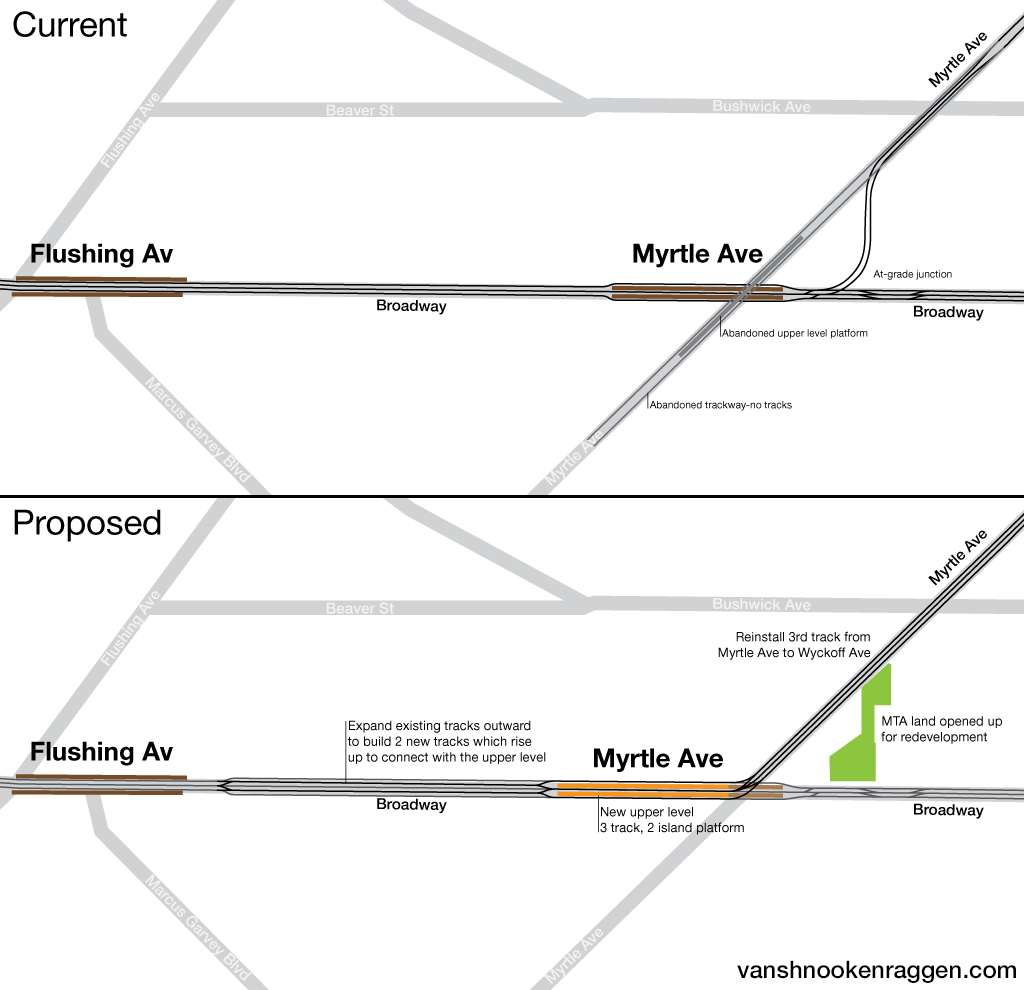
A dual level station like what I am proposing has precedent throughout the NYC Subway. At West 8 St on the Brighton Beach Line (Q train) and the Culver Line (F train) each train has a separate level with the Q train rising up to the upper level exactly how the new Myrtle Ave connection would do so. Historically at Gun Hill Rd on the White Plains Line (2/5 trains) there was a similar connection with the now demolished 3rd Ave El with each line on a separate level and then merging north of the station. Not only does this design eliminate trains having to pass in front of one another but in the case of Myrtle Ave the sharp 90 degree curve would be eliminated so trains can turn faster and safer, not to mention the reduced wear and tear as well as noise.
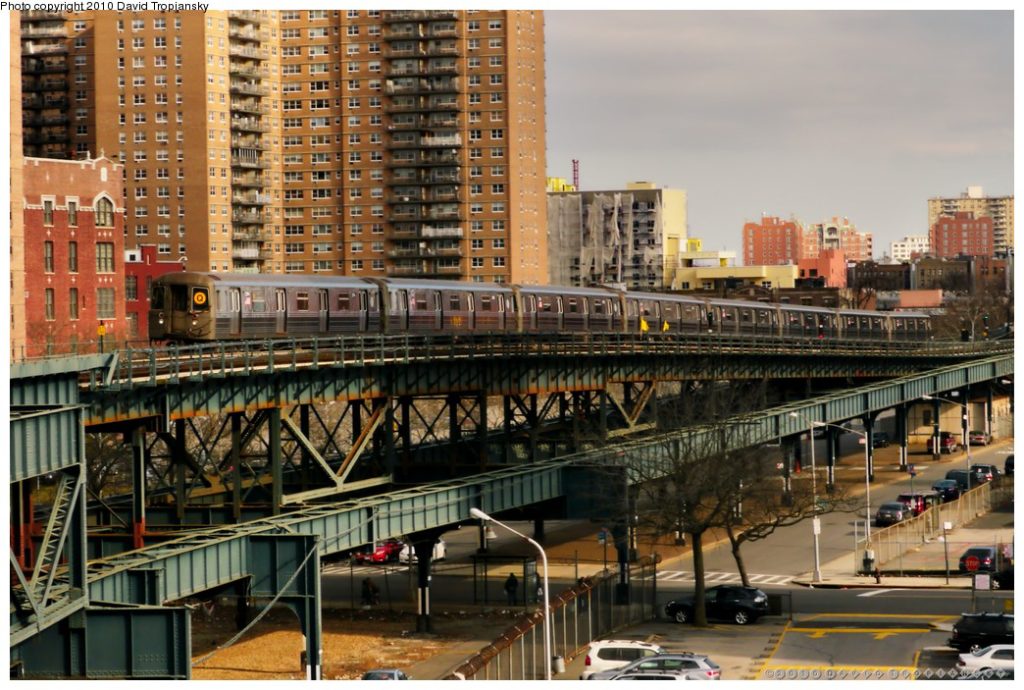
The repairs the MTA is undertaking next year are part of a larger recovery plan and not part of any long range strategy. As time is of the essence when it comes to the Canarsie Tubes I cannot fault the MTA for deciding to go for the quick option for rebuilding the Myrtle Ave connection. But as more and more people move into central and northern Brooklyn the limitations of our existing infrastructure are becoming apparent.

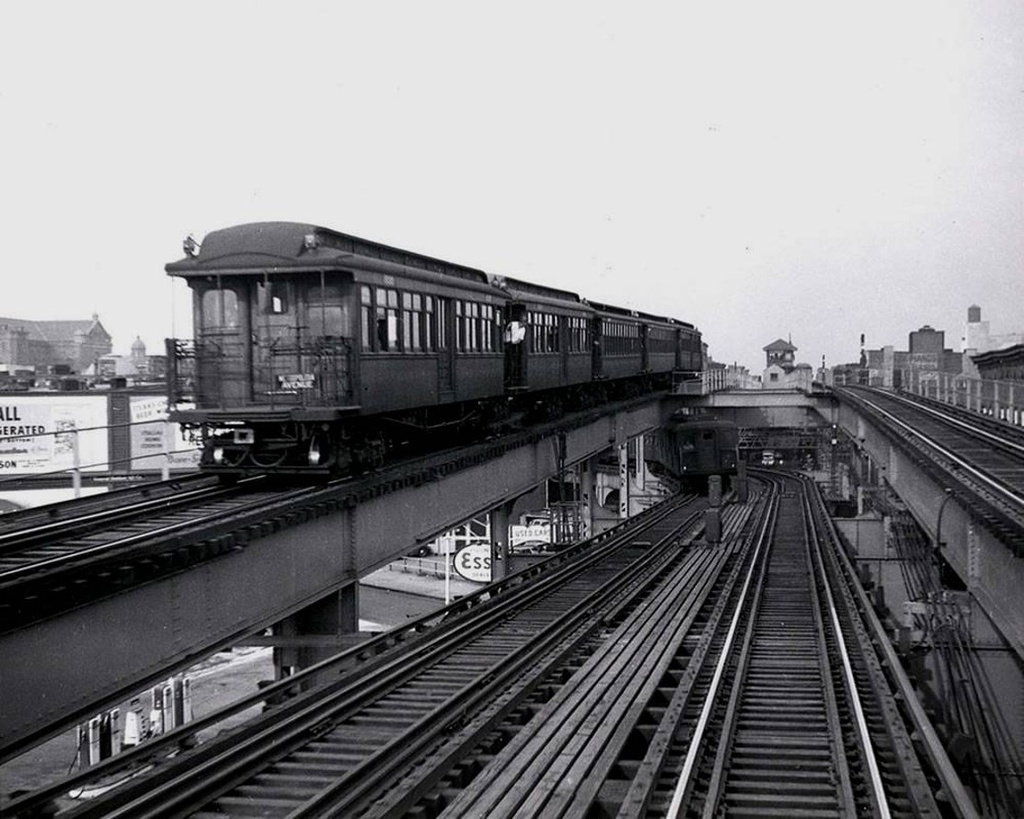

The proposed solution of a new 3 track/2 platform level elevated structure over and connecting to the existing tracks is great from a transportation perspective but does not strike a balance with nearby community (hating elevated structures and likely to opposed any addition to them) and financial concerns.
Much of the desired improvement could be accomplished for far cheaper by just raising the existing east bound (local) track one level and having its station directly over the existing westbound station (allowing for one elevator to serve both). The east bound junction for the the myrtle avenue (metropolitan avenue bound) line would then connect fly over the west bound tracks.
Eastbound you have 1 track splitting into two so there should be no delays. Westbound trains can wait at before the junction thus not delaying each other.
One would not have have a (direct) connection to the center broadway track to the myrtle avenue line the the need for this is questionable especially giving both the financial and aesthetic benefits of the this reduced scale idea.
You are correct that adding more elevated structures will face opposition. The cheapest and easiest (in terms of construction) solution would be to build a new eastbound track past Myrtle Ave which flies over the other tracks and turns down Suydam St or Hart St. The obvious issue with this is that it would require eminent domain to take buildings and would inflict a new elevated structure on previously unaffected streets. The compromise with my plan is that it keeps all the new structure compact and doesn’t impact any new streets.
The issue I see with your plan is the center track, which you mentioned. The problem is that because the J runs express so frequently riders often bunch up the platform at Myrtle Ave waiting the the M train. A single island platform would be dangerously overcrowded at rush hour so the second platform would be needed.
Why not just build an eastbound track heading down Lewis that reuses Myrtle Av upper level? A single track would require minimal takings and also reuse existing infrastructure.
That would swap one 90 degree curve for another and would require taking property. Reducing the track curve speeds up trains and reduces wear and tear.
Reducing curves in this particular location is not going to do much though, because the curves are immediately outside stations, where trains should be at slower speeds anyways.
If you were to construct a track curving from the western side of Lewis onto the eastern side of Mrytle, you would only need to take the parking lot on the corner that is currently there. It’s not like you need to demolish a school (and honestly, the parking lot could probably still be under the tracks once all is said and done.)
I read about the myrtle broadway replacement station diagram will it has a chance for the 75′ trains to run on this line before it retires ?
Probably not since it would require extending the station platforms on all the stations. Also I read that the Chrystie St Connection (btwn 6th Ave and the Jamaica Line) is too tight for 75′ cars… though I don’t know that officially.
The suggestions regarding the Myrtle Avenue and Broadway station are interesting, However the big bottleneck has always been the Williamsburg Bridge itself. If it had greater capacity, the grade level connection between the Myrtle and Broadway lines would be more of an issue.
Ironically when the bridge was built there were 6(!) lanes for rail, 2 for subway(el) and 4 for trolley. The reason that the Centre St Subway was built with 4 tracks was that it was assumed that 2 of these trolley tracks would some day be upgraded for heavy rail. Obviously this never came to pass and automobiles took their space. I wonder though how important this bottleneck really is since trains can wait at the station to merge. It’s really at Marcy Av where trains switch where there is a bottleneck. Express trains need to stop at Marcy Av anyway and there doesn’t seem to be space, however, to rebuilt it as a 3 track station (remember that the Broadway el used to run down to the ferry at Kent Av before the bridge made it obsolete). This could have been fixed when the Williamsburg Bridge was renovated in the 90s but obviously the traffic wasn’t there to justify adding a 3rd track. It seems to me that at this point the only option is to deal with the Myrtle Junction.
Long term I see the need for a new East River tunnel to Williamsburg and I’ve played with many scenarios on how the new tunnel could interact with the elevated line or burring part or all of the Broadway el. My preferred alternative so far is to bury the el from Havermeyer St (so right off the bridge) where it will meet up with the new tunnel to Manhattan and then run out to Lenoard St where a new portal will be built to connect with the existing el out to Jamaica. At Union Av the J/Z would head into Queens via a new subway up Flushing Av and the B/D takes over the el route to Jamaica. This seems like the best option given the growth in northern Brooklyn (M train ridership is up 20% in Bushwick and Ridgewood over the last 5 years) while J/Z trains would do better to connect Flushing with lower Manhattan giving some relief to midtown transfer stations. The obvious problem? It’s a large plan with many moving parts… something that NYC doesn’t seem to be able to build very well, or at least quickly.
Anyway, the whole el is a relic from another time and maybe it is with considering demolishing the whole thing. Had the IND Second System lines been built it would have been removed long ago.
Thanks for the information on the history of the planned service on the Williamsburg Bridge. I was unfamiliar with that. Your ideas bring a couple of thoughts to mind regarding the delayed use of facilities built decades ago. First is that the 63rd St. tunnel was built, I believe, in the 1970s and then sat unused for all those years. But it is now being used. If your suggested new East River tunnel could get built, even if it weren’t initially used, it would still start the process like the 63rd St. tunnel did. And second, with regard to the long lost IND Second System, we still have the intriguing station shells at South 4th St. and Utica Av./Fulton St. They have now been around for about 80 years. Who knows? By the year 2100 they might find a way to integrate and actually use them!